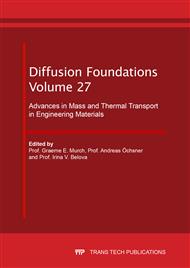p.73
p.90
p.99
p.115
p.122
p.136
p.166
p.177
p.186
Atom Motion in Solids Following Nuclear Transmutation
Abstract:
Following nuclear decay, a daughter atom in a solid will "stay in place" if the recoil energy is less than the threshold for displacement. At high temperature, it may subsequently undergo long-range diffusion or some other kind of atomic motion. In this paper, motion of 111Cd tracer probe atoms is reconsidered following electron-capture decay of 111In in the series of In3R phases (R= rare-earth). The motion produces nuclear relaxation that was measured using the method of perturbed angular correlation. Previous measurements along the entire series of In3R phases appeared to show a crossover between two diffusional regimes. While relaxation for R= Lu-Tb is consistent with a simple vacancy diffusion mechanism, relaxation for R= Nd-La is not. More recent measurements in Pd3R phases demonstrate that the site-preference of the parent In-probe changes along the series and suggests that the same behavior occurs for daughter Cd-probes. The anomalous motion observed for R= Nd-La is attributed to "lanthanide expansion" occurring towards La end-member phases. For In3La, the Cd-tracer is found to jump away from its original location on the In-sublattice in an extremely short time, of order 0.5 ns at 1000 K and 1.2 ms at room temperature, a residence time too short to be consistent with defect-mediated diffusion. Several scenarios that can explain the relaxation are presented based on the hypothesis that daughter Cd-probes first jump to neighboring interstitial sites and then are either trapped and immobilized, undergo long-range diffusion, or persist in a localized motion in a cage.
Info:
Periodical:
Pages:
186-196
Citation:
Online since:
May 2020
Authors:
Price:
Сopyright:
© 2020 Trans Tech Publications Ltd. All Rights Reserved
Share:
Citation:


